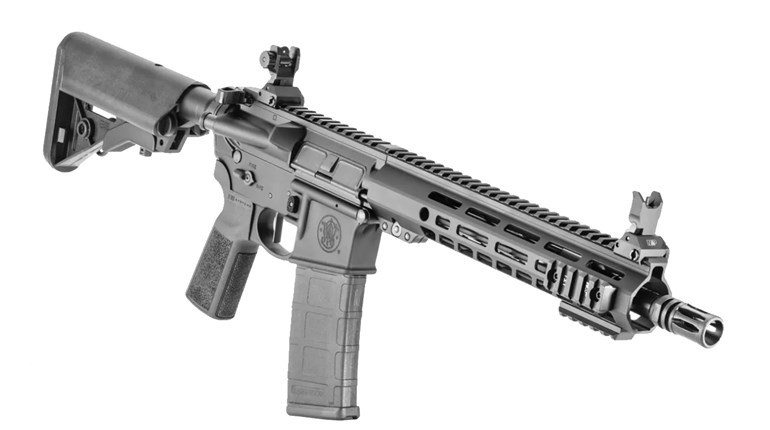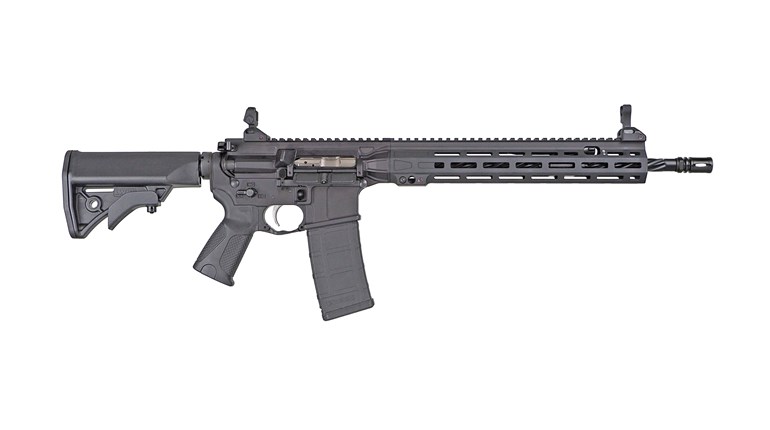
Back in 2011, I wrote a column describing the technical aspects of and registration process for Short Barrel Rifles (SBR), briefly explaining their limitations outside of the battlefield. I have since come to more fully appreciate the SBR’s usefulness far beyond traditional military and law enforcement roles. SBRs are well-suited to the many tasks we push our multi-purpose rifles to do these days: defense of home and property, target shooting, hunting, back-country hiking and disaster preparedness.
Since 1934 the federal government—via the National Firearms Act (NFA)—has defined rifles with barrels less than 16 inches (or an overall length of less than 26 inches) as “Short Barrel Rifles” needing special registration and taxation. The SBR classification was purportedly related to violent crime during the 1920s and ’30s, but in reality that makes no sense at all. Just as with all laws criminals break, the NFA only hamstrings and places undue financial and bureaucratic burdens upon law-abiding citizens. I seriously doubt such laws have ever stopped a single long gun from falling victim to a criminal’s hacksaw. Nonetheless, we are stuck with this onerous registration process until at least one of our three branches of government either codifies or rules SBRs are nothing more than utilitarian—rather than sinister—tools.
Most of my Army career was spent with various issued SBR-length arms in my hands, so my opinions on their strengths and weaknesses used to be shaped by Mil-Spec guns that were made with portability in mind. Accuracy, ergonomics and sometimes even reliability suffered in those days and our direct-impingement (DI) and piston-driven short guns were best used in very specific roles.
The rifle landscape today is far different: SBRs can be made to shoot very accurately and reliably provided the right components are used and the builder/manufacturer actually understands what is happening inside that gun during the cycle of operation. Sometimes, I even find that shorter barrels shoot better than longer ones in a given caliber and gun type. We really are not breaking any new ground here. Accuracy purists have long known that shorter barrels are stiffer than their longer siblings and that stiffness often yields better accuracy for a number of reasons. The qualifier here is you can reach a point of diminishing returns when shortening barrels because weight is shed along with length. The resulting increase in felt recoil and concurrent muzzle movement from harder-recoiling cartridges can severely affect a rifle’s “shootability.”
Even milder cartridges like .300 BLK start to make their presence known in the tiny, pistol-length barrels, which are so popular now. So, while an SBR may shoot well in a fixture or off a benchrest, what matters most is whether or not you can place rounds where you need them under more-practical conditions.
Heavy buffers and recoil springs help reduce muzzle movement and felt recoil to some degree. Good muzzle brakes and tuned gas systems are also big pluses here. Most shooters perceive a smoother shot-to-shot experience when a rifle’s operating system has been slowed down. Gas-
system tuning is also the most-effective way I have found to ensure a direct-impingement SBR’s reliability does not suffer from its stubby length. I set my gas port sizes as small as possible while still allowing each rifles’ operating system to function with the lightest loads I use.
Sound suppressors are great for holding down a bucking short barrel, but you have to be willing to pay for that second transfer tax stamp and jump through the same hoops as you did for an SBR to get one. Here again, a tuned gas port size or adjustable block helps eliminate the reliability issues we saw back in the bad old days. Always check a sound suppressor’s specifications for the minimum barrel length it is rated for in a given caliber.
Remember that each inch of barrel lost equals a reduction in muzzle velocity. Greater elevation adjustment is needed to get those slower bullets to your intended points-of-impact and winds will push those bullets around more along the way. Reduced velocity can affect expanding projectile performance, too, so effective distances are shortened as barrel lengths shrink. Muzzle flash is often pretty atrocious with conventional ammo that was designed with enough powder to boost velocity and operating pressure in longer barrels.
Perhaps the least-known negative aspect of short-barrel rifle ownership is that unless you are a Class II or III SOT license holder, it is against federal law to transport your legally registered and tax-stamped SBR across state lines without the prior blessing of the BATFE’s NFA Branch. This can come through the approval of either a written request or an ATF Form 5320.20. Blanket authorizations may be granted to transport to and from a single location for one year at a time. This rule also applies to NFA-controlled short-barrel shotguns (SBS), full-auto firearms and so-deemed “destructive devices,” but it does not apply to sound suppressors. I can think of no rational explanation for this rule—and the single exception—beyond making life harder for law-abiding citizens.
Finally, remember that just because you can buy an upper receiver assembly with a barrel shorter than 16 inches, that does not make it legal to attach it to your lower. Doing so violates the NFA, so be sure to follow all regulations regarding the SBR manufacturing and registration processes first.
With all these caveats to short-barreled rifles’ coolness factor, why are they becoming so popular? I think it is because they are very easy to store and carry, especially in areas of thick vegetation, tight confines and restrictive terrain. SBRs are lighter and, in smaller calibers, make great teaching tools for new shooters. Whether in bullpup form like IWI’s new X95 or with a folding stock like that of the SIG Sauer MPX, FN SCAR or Law Tactical’s AR folding-stock adapter, SBRs are highly portable, reliable, capable of acceptable accuracy and damn fun to shoot…often.





































